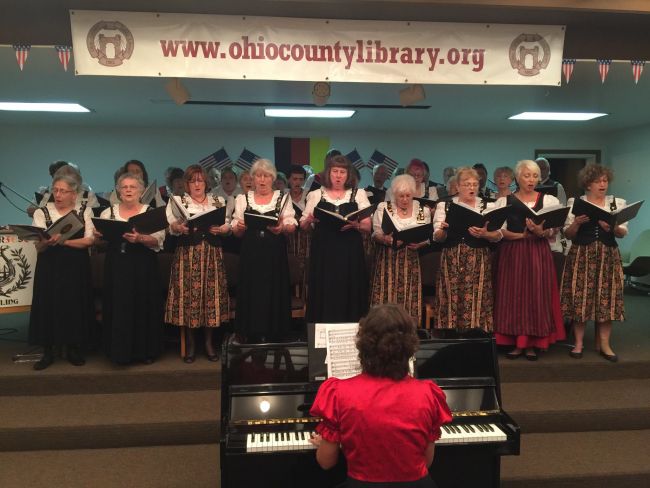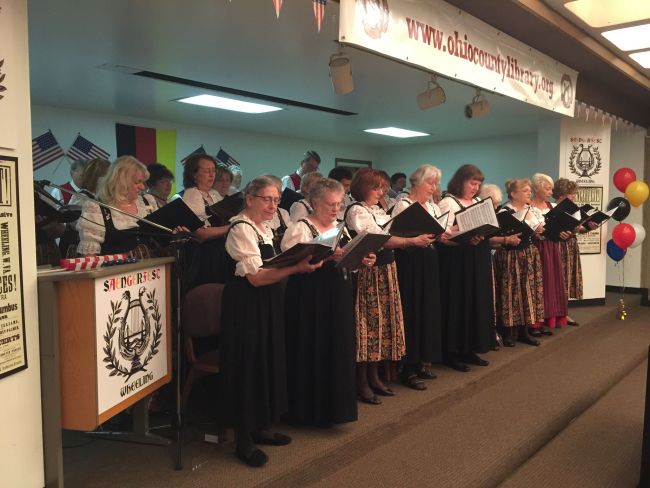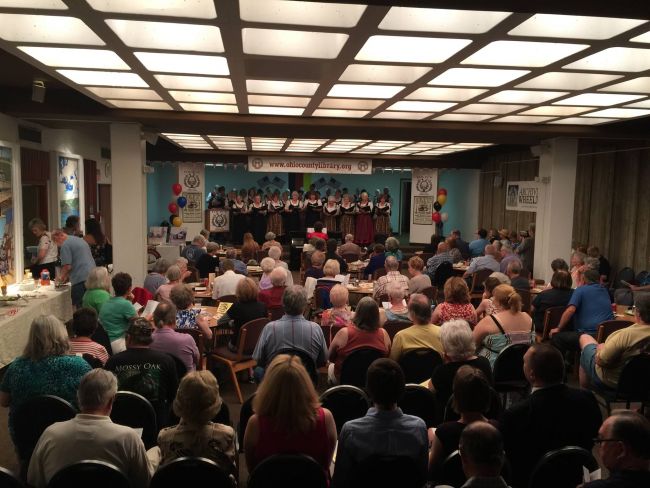Music in the Air: Wheeling's 1906 Saengerfest Revisited
Germantown

The Wheeling of one hundred ten years ago was a robust German town, with a German language newspaper, mandatory German language classes in many schools, and German language services in many churches.
It was also home to numerous German choral singing societies, including the Arion, Harmonie, Maennerchor, Beethoven, Germania, Liedertafel, Mozart, Concordia, Liederkranz, and Teutonia. The Turner (or Turnverein) Society emphasized gymnastics and operated Turner’s Hall. The singers were mostly male, accompanied, when needed, by female singers from the women’s auxiliaries. The societies often had their own musicians.
In addition to their individual concerts, which often featured formal balls and dinners, these patriotic groups joined forces annually to sponsor Wheeling’s biggest 4th of July celebrations at the Fairgrounds on Wheeling Island.

The German singing societies also sponsored three big regional singing festivals, or Saengerfests in Wheeling in 1860, 1885, and 1906. Other societies journeyed to town from far-flung cities in West Virginia, Pennsylvania, and Ohio to join their Wheeling brothers and sisters for a few days of concerts, parades, and picnics. The 1860 Saengerfest featured performances in Washington Hall and the Athenaeum (converted not long after to a Civil War military prison). The 1885 Saengerfest was held at Alhambra Palace Hall, a huge roller skating rink at Chapline and 33rd Streets, and ended with a “Monster Parade” and “Grand Excursion to Wheeling Park.”

By the time of Wheeling’s 1906 Saengerfest (held for the Central Ohio Singing District) only the big three Wheeling societies were still in operation: the upper crust Arion (a merger of the Harmonie and Maennerchor), which operated Arion Hall at 20th and Main Streets; the working class Beethoven, which also met at Arion Hall and would be the last of the Wheeling societies still standing, surviving until 1961; and the working class, South Wheeling-based, Mozart (a merger of the Concordia and Liederkranz supported by Henry Schmulbach and his brewery employees), which had a hall at 38th and Jacob and operated Mozart Park (and beer garden).

Gardens of Beer
Schmulbach’s chief rival, brewer Anton Reymann, was a prominent member of the Arion Society, and operated his own beer garden at Wheeling Park. In fact, German beer gardens seemed to be around every corner in Wheeling at the time, from Mozart and Wheeling Parks, to Seibert’s Pavilion in Edgwood. And beer was certainly a popular beverage at the German singing festivals, as Wheeling’s singers fondly remembered the previous Saengerfest in 1904 in Akron where the Cleveland delegation wore hats with the German words for “What will you have?” on the front and on the back, “Always beer!”

There was even a German beer garden on the Coney Island amusement park in the river near Warwood, which had spared no expense in preparation for the 1906 Saengerfest, paying top dollar to book the hottest aerial act around that summer: the “French equilibrist” (tightrope walker) Arabie Philion. “Between 5000 and 7000 people saw [Philion] yesterday,” the News-Register reported. “The steamer Avalon was crowded to its capacity on each trip and as many more went up on the traction cars.” Large Saengerfest crowds were expected for Philion, who “stands upon a globe 28 inches in diameter and propels it up a spiral runway 160 feet long and then out upon an imitation cable 50 feet in length. The dare-devilry of the performance is accentuated by the fact that Philion does not have a net stretched to catch him in case he falls…In the night performance he released a fountain of fire, which enveloped him as he descended to the runway.” The News-Register pronounced Philion’s show a “novel, pleasant, and thrilling act” and encouraged Saengerfest visitors not to miss it. According to newspaper accounts, not many did.
Just three days later the Wheeling Amusement Company, which owned Coney, was sued for $500. The cash drawer was levied but only contained a paltry $100, so the owners were given until the end of the week to reach a settlement to avoid a forced sale of the island. The manager, Mr. Driehorst, was “said to have been apprised of the deputy sheriff being in possession of papers for the island, and he beat the deputy to it by about fifteen minutes via the ‘airship’ line,” the News-Register joked, mocking the popular “Airship to the North Pole” attraction at Coney Island. The big 1907 flood would bring an end to the unlikely river resort.
The Biggest

Wheeling’s August 21-23, 1906 Saengerfest was the biggest of them all. Held primarily at the Court Theatre, it featured, in addition to Wheeling’s big three (under the direction of Professor Herman Shockey), 24 visiting singing societies, including: Akron Saengerbund and Akron Leidertafel; Alliance Harmonie; Canton Arion; Cleveland Harmonie, Cleveland German-Hungarian Society, Cleveland Newburg Germania Mannerchore, Cleveland Schwabischer Saengerbund, Cleveland Turner Mannerchore, and Cleveland Deutsch Ungartscher Saengerbund; Columbus Germania, Columbus Leiderfranz; Dayton Mannerchore, Dayton Schwabischer Saengerbund; Lima Orion; Mansfield Arion; Marion Deutsch Bund; Parkersburg (WV) Germania; Sandusky Schfabishcer Saengerbund; and Youngstown Mannerchore.

Also in town was the Chillicothe Eintracht which, back in 1885 when the Saengerfest was also a singing competition, had won a “silver loving cup.” They forgot to bring the cup back to Wheeling with them in 1906, when the competitive aspect had been discontinued because it had “led to ill-feeling.”
As each society arrived they were “met at the [train] depot by the reception committee and a band [typically the Opera House Band] and escorted by them to Arion Hall” for refreshments and then to their headquarters.
With between four and five thousand extra passengers expected per day, local railroads offered special trains, including the Pan Handle from Butler and Columbus, the B&O from Pittsburgh, Parkersburg, and Cleveland and the Wheeling and Lake Erie from Cleveland. And with so many thousands of visitors expected to descend upon the city, the hotels offered special rates and were soon booked so full, most reportedly had “a large number of cots placed about in the parlors and halls,” with still more visitors having to be placed in private homes.
The idea of the streets teeming with out-of-towners had the Wheeling Police on high alert, expecting, “pickpockets and crooks of a similar nature.” But in the end, the police seemed almost disappointed by how few crooks actually went to work.


In keeping with a request made by Wheeling Mayor Charles Schmidt in his official Saengerfest Proclamation, many buildings throughout town (including Stone & Thomas, Arion Hall, and the Court) were draped with German and American flags and bunting for the occasion. “…the city had put on its gayest attire and all thoroughfares are lined with buildings displaying flags, festoons and streamers of the American and German colors.” The decorations by H. F. Behrens Company on South Market were said to be the most artistic by the “saengerbruders,” with German and American flags artfully arranged all over the front of the store.
The Streets Were Alive

The streets of Wheeling had never been so alive with the sights and sounds of spontaneous singing, performance, and musicianship. The town was transformed into a German version of New Orleans. As they marched in the sweltering downtown street from their hotels to the Court to perform, the societies were usually accompanied by a “band of music.” Impromptu concerts broke out on street corners. The Cleveland German-Hungarian Society was the first to enlist an uninvited group tagged the “Leedle German Band” to play music as they walked from place to place. Other delegations followed suit, picking up the “Leedle German Band” to head impromptu parades. “There was music in the air after the concert last night,” the News-Register observed, “and the inevitable ‘Hi-lee hi-lo’ was sung freely on the street. All the visitors appeared to be having a good time. Many of the societies wore uniform caps, some of them with inscriptions in German across the visor.”

The biggest of Saengerfests was also a big marketing opportunity. In addition to an official lithography filled program, official badges were sold at Arion Hall and the Court, “…neat celluloid affairs, surmounted by the German flag, and bearing the words: ‘Tenth Central Ohio Saengerfest…Wheeling, W. Va.”
The New York Staats Zeitung, the largest German daily newspaper in the country had a reporter at the events, and enterprising local newsboys “had supplied themselves with a large number of copies of [Wheeling’s] German Daily, Duetsch Zietung, and were hawking their wares along the streets.”
Stores like C.A. House, House and Hermann, Hancher Jewelers, and Palace Furniture and Undertaking Parlor ran newspaper ads targeting Saengerfest attendees. In its ad welcoming the singers themselves, Stone & Thomas reminded them that they were required to wear a white vest and black bow tie, both of which they could purchase at – wait for it – Stone & Thomas, for just 98 cents to $3 per vest and only 25 cents per tie!
Opening Night
The sixty-piece Cleveland Symphony Orchestra, conducted by Ludwig Van Beethoven doppelganger Johann Beck, served as the primary orchestra, backing a chorus of 700 men (for whom a huge wooden scaffolding was special built on top of the Court’s stage), and another chorus of 600 children directed by Miss Lucy Robinson that, attired all in white, sang “Old Glory” “Dixie” and “America” while waving small American flags.
On opening night, August 21, with “a large German flag and on either side smaller American flags,” at center rear of the stage, “The curtain rose at 8:15…and from the rear, row upon row, from the extreme back of the stage forward and from the extreme of either wing in tier upon tier sat the immense chorus of 700 persons.” Beck led the symphony’s performance of Wagner’s Imperial March…” and then, “the largest song body ever heard in Wheeling” performed “Sing and Forget.” The volume was immense,” the Intelligencer reported, “but not to such an extent that it was rendered unpleasing…”
Vaterland vs Ould Sod
Not all of the Saengerfest visitors were of German extraction. John Garrity the Irish “tinner” from “the ould sod” via Parkersburg was making the rounds at the Saengerfest concerts and parties, which he reportedly enjoyed “with a keen relish.” He became well known for “cracking jokes” and was “generally a center of a jolly crowd wherever he might go…”
Meanwhile, the vaudeville acts at Wheeling Park attracted both Irish and Germans, who “Thronged” the park. “It was the A.O.H. [Ancient Order of Hibernians] picnic,” the News Register’s version began, “but the Germans outnumbered the sons of the Ould Sod two to one. However they mingled together and all were out on pleasure bent and they certainly had it. After the excellent vaudeville performance, the Saengerfest visitors formed in bodies of about fifteen, each body having a leader, and then there was singing in every part of the park. This singing was kept up until they arrived in the city. And each one had a grand time, and only such a time as a German at Wheeling Park can have. Every amusement was indulged in and the refreshment counter was well patronized.” Indeed, the presence of so many hardcore German and Irish pleasure-bent amusement seekers at his park must have meant quite a boon to Mr. Reymann and the sales of his particular, hoppy refreshments.
A Heat Wave

In the end, attendance at the official Saengerfest concerts was lower than expected, and the low numbers were blamed on an August heat wave that peaked at 96 degrees. In fact, the temperature inside the Court Theatre, packed with 700 choral singers, was stifling, and attendance at the outdoor venues received a corresponding boost.
Eschewing the superheated indoor events, many visitors hopped the trolleys to visit neighboring towns, the parks, and Coney Island, while the Mozart, Arion, and Beethoven halls were left open for visitors to come and go.
Even so, enough spectators showed up at the Court on the final night that, when they joined with the 700 singers on stage to sing the Star Spangled Banner. “…the big auditorium rang with the harmony of the grand old national anthem and on the chorus the audience rose and joined in and 1,500 voices breathed out the country’s tune. It was a wonderful climax to a wonderful song festival and ended Wheeling’s greatest musical affair.”
Court Theatre manager Richardson and a team of just four men rather quickly dismantled the huge lumber scaffolding erected on top of the Court’s stage, which had impressively held the 700 singers without incident and without a single nail having been driven into the stage itself.
Volkfest!

Parede Order
But the last concert was not really the end. The festivities ended in grand German style with another monster parade or Volkfest. The societies assembled at Arion Hall about 600 strong, and accompanied by the Opera House Band, Meister’s Band and six others, marched up Market to 10th, down Main to 23rd, then over to Chapline, and down Chapline to 29th, where they hopped the incline street cars (along with thousands of others) to Mozart Park for a massive, Schmulbach beer-fueled picnic and party with dancing, bowling, shooting and general merriment.
Mozart Park, was “thronged Afternoon and Night,” with an estimated 4000 people (the Intelligencer had the number over 10,000). “The Opera House Band,” said theNews-Register, rendered the concert music and Meister’s Orchestra furnished the music for dancing. The large pavilion where the devotees of the terpsichorean art held sway was crowded all the time during the afternoon and evening.” Banners were placed around the park to mark where each society was to congregate and have lunch.
In the shooting contest, Henry Beu won first prize: a silk umbrella. Second prize was a box of cigars, third a pipe. Bowling champ John Roth won a “handsome water pitcher.” A “beautiful stein set” went to the second and third place bowlers.
Though they managed to transport visitors up the hill to fill the park without incident, four City Railway Company cars jumped the tracks while lugging the huge crowd back down the hill. Fortunately, there were no serious injuries.
Wheeling’s biggest (and last) Saengerfest had come to a rousing end.
The next biennial Central Ohio Saengerfest was scheduled for Canton in 1908 in June “to escape the heat of August.”
Wheeling De-Germanized
Despite the grand success of the 1906 Saengerfest, and despite Wheeling’s status as a staunchlyGerman town, just a few years later, the town’s distinctive German character would be virtually erased. America’s entry into the Great War sparked a highly effective national propaganda campaign against the German enemy. The ensuing anti-German backlash caused dramatic changes in Wheeling. In 1918, all German language instruction in city schools was discontinued, Wheeling businesses like the German Bank dropped the word “German” from their corporate names, and all of the German Singing Societies (except for the Beethoven) became extinct. And Wheeling would never again experience the merriment of a Saengerfest, that is, until the Ohio County Public Library revived the tradition in 2010.
Saengerfest Revisited
And on Sunday, May 29, 2016, the library will welcomed back the Liederkranz-Turner Club, a German singing society from Dayton, Ohio, accompanied by the Kolping Society of Cincinnati. The Liederkranz-Turner singers were in town in 2010 to mark the 125th anniversary of Wheeling’s 1885 Saengerfest. So memorable was their first Wheeling experience, they requested a return, along with their friends from Cincinnati, to mark the 110th anniversary of the last Wheeling Saengerfest in 1906.
After an introduction by Dr. David Javersak to provide the historical context, the Liederkranz-Turner Club and the Kolping Society performed. Free German festival food created by Chef Chris Kefauver and the culinary arts department at West Virginia Northern Community College was served.
The program was dedicated to the late Dr. Edward C. Wolf, whose research and writing ensured that Wheeling’s German singing societies would not be lost to history.
Fun was had by all...
See the Saengerfest program.
See photos of the 2016 Saengerfest.
SAENGERFEST 2016!

Get Your Own Special Saengerfest Edition Magical Then & Now Postcard!
Click Here to See the Magic!
Our limited edition "lenticular postcard" shows Arion Hall at 20th and Main decorated for the 1906 Saengerfest. Tilt the card and watch the view transform 110 years into the future, to 2016!
You can get one of these high quality 4 x 6 cards for your collection while supplies last. Only $5 each!
All proceeds benefit the library Archives.
Supplies are limited, so stop by the library or send us an Email to get yours today!
Events in Wheeling | Wheeling History Home | OCPL Home
The materials on this website may be freely used by non-commercial entities for educational and/or research purposes as long as credit is given to the Ohio County Public Library, Wheeling WV. Content within these pages cannot be reproduced in any format for profit or other presentation without the permission of The Ohio County Public Library. To obtain permission to publish images or other material available on this website, contact us through our Ask a Librarian form.










 Want to keep up with all the latest Library news and events?
Want to keep up with all the latest Library news and events? 












.jpeg)
.jpeg)